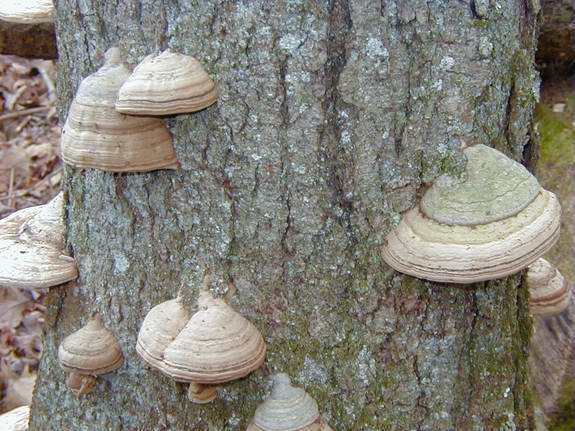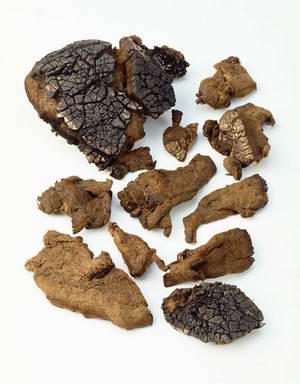|
Return to Hiker's Notebook Home Page
Common Name: Tinder Polypore, Tinder fungus, Touchwood, Punk, German tinder, Fire-starter mushroom, German felt, Hoof fungus, Surgeon's agaric, Agaricus chirurgorum, Amadou, Amadouer (France), Tsuriganetabe (Japan), Wundschwamm (Germany), Esporija pare heridas (Italy)- The preponderant references to tinder correspond to the widespread use of the fungus for fire initiation and fire maintenance.
Scientific Name: Fomes fomentarius - The Latin word fomes means "tinder" or "touchwood" and the Latin word fomentarius means "material to feed a fire" - both the generic and species names emphasize the use of the fungus for fires. Formerly known as Polyporus fomentarius and Ungulina fomentarius.
The Tinder Polypore is one of the most readily identifiable of the bracket fungi, which means it is laterally attached like a bracket to a substrate without a supporting stalk. The shape and proportions are suggestive of a horse's hoof; the common name hoof fungus provides a descriptive mnemonic. The tinder polypore is weakly parasitic on broad-leaved trees, notably beech and birch. The pathogenic infection is known as white heart-rot: the disintegration (rot)of the central wood of the tree (heart) through consumption of the brown lignin so that only the cellulose which is generally light in color (white) remains. The fungus is also saprobic, living on the dead trunk or remnant stump of the tree that it may or may not have had a hand in killing. The "hoof" portion of the fungus has a crusty grey-brown, zoned upper surface, the bottom is comprised of a cream-colored surface that is covered with pores that are about a third of a millimeter in diameter. Spores are produced in prodigious numbers in the spring and summer, as many as 800 million in a single hour according to field testing; very few spores are produced in the autumn and winter.
The many common names of F. fomentarius in numerous languages reflect a global cultural association and a wide range of practical applications; its use as a means to start a fire as tinder is probably of greatest notoriety. The historical and ancient method of "German tinder" preparation was to remove the hard outer rind of the fungus and cut the softer, fibrous interior flesh into strips that were placed in a pot filled with enough urine for submersion. Saltpeter (potassium nitrate) can be substituted as a chemical alternative to urine in more modern applications. The urine-fungus concoction was then boiled for several days with the periodic addition of urine. At the completion of the process, the fungus was removed, drained and dried; the resultant admixture had combustive properties that made it exceptionally well suited for use as touchwood to start a fire. The common name Amadou is a calque from Amadouer, the French name for the fungus which means to coax or cajole. It may be presumed that this etymological association arose from the use of the Amadou to coax a fire along when first started. The slow-burning properties of the tinder fungus also provided a critical means of fire transport from one camp location to another. E. Schaechter relates in the book "In the Company of Mushrooms" that the Atabascan people of Alaska called the fungus "growth from a tree" and used it to transport a fire from one location to another as did the Cree Indians of Northern Quebec. The common name punk attests to the use of the tinder fungus as a means of maintaining a lighted ember. According to Paul Stamets in "Mycomedicinals," punk became popular in the Middle Ages with the spread of the flintlock rifle which used the spark from a flint to ignite the fungal punk which provided adequate amplification to ignite the gunpowder and discharge the weapon. In the halcyon days of yore when firecrackers were legal and relatively plentiful, punk was a very effective ignition implement.
F. fomentarius was also widely used as a styptic to stop bleeding and as a vulnerary to treat wounds. This practice dates to Hippocrates of Cos (460 - 370 BCE), the Greek physician who, as the "father of medicine" was the progenitor of the notion that illness was the result of an imbalance among the four humors of blood, black bile, yellow bile an phlegm. The "Hippocratic Corpus" is a body of works attributed to both Hippocrates and his students which contains the prescriptive: "�if the pain settles somewhere else, cauterize: burn fleshy parts with irons, osseous and fibrous ones with fungi." In the absence of any linking common or scientific names, the use of the tinder fungus is presumed. The styptic function is evident in the various references to this application in the common names in several languages. The German Wundschwamm literally means "wound sponge" and the Italian Esporija pare heridas means "sponge for the wound." In English, the fungus is also known as Surgeon's agaric and Agaricus chirurgorum. The agaric name comes from the Greek Agarikon, which means fungus - the fungi of the genus Fomes were frequently referred to as agarics, particularly when used in the manufacture of punk. A chirurgeon is an earlier form of the word surgeon; the Latin surgery is chirurgia. The styptic function is a testimonial to the water absorbing properties of the tinder polypore. The common name German felt refers to the kneading of the tinder fungus inner flesh into a felt-like fabric used to make water-resistant hats. It is still in use for its water absorbent properties today. Amadou pouches are sold to fisherman for the storage of artificial flies; the fungus draws the moisture from the fly to restore the evanescence necessary to allure piscine predators.
The salubrious use of the Surgeon's agaric for staunching wounds was doubtless enhanced by its attendant medicinal benefits. Numerous modern researchers have demonstrated that F. fomentarius has anti-tumor and antibacterial properties, attributed to iodine and to a substance aptly named fomentariol. It was used by a number of Native American tribes to treat arthritis, by the healers of ancient China as a cancer medicine, and by the peoples of South Asia as a diuretic and laxative. The Native Americans of Siberia used it in powdered form as a snuff-like nasal inhalant. It is even reported to be one of the better palliatives for an ingrown toenail, strips of the velvety felt being placed between the toes.
|

 The
widespread use of the tinder polypore in ancient times was a matter of
historical conjecture until 1991 when it was affirmed with archaeological
certainty; Austrian hikers found a frozen corpse half emerged from the
Schnalstal Glacier in the Tyrolean Alps. The hapless wayfarer was thought to
be of relatively recent mortality and was taken to Innsbruck, Austria for
investigation. It was quickly determined based on the artifacts found with him
that he was of much older provenance - a 5000 year old Neolithic European who
lived during the Copper Age. He was christened Oetzi or �tzi for the region
of Italy adjacent to the alpine pass of his demise. His death was attributed
to exposure. In 1998, careful geographic coordinates of his bier confirmed
that he was actually found in Italy; Oetzi was accordingly moved to the South
Tyrol Museum of Archaeology in Bolzano,
The
widespread use of the tinder polypore in ancient times was a matter of
historical conjecture until 1991 when it was affirmed with archaeological
certainty; Austrian hikers found a frozen corpse half emerged from the
Schnalstal Glacier in the Tyrolean Alps. The hapless wayfarer was thought to
be of relatively recent mortality and was taken to Innsbruck, Austria for
investigation. It was quickly determined based on the artifacts found with him
that he was of much older provenance - a 5000 year old Neolithic European who
lived during the Copper Age. He was christened Oetzi or �tzi for the region
of Italy adjacent to the alpine pass of his demise. His death was attributed
to exposure. In 1998, careful geographic coordinates of his bier confirmed
that he was actually found in Italy; Oetzi was accordingly moved to the South
Tyrol Museum of Archaeology in Bolzano, Italy, where he is on display in a specially refrigerated catafalque. The
Italians conducted an independent inspection and found that he had an
arrowhead lodged in his back, a much more plausible cause of death. Among his
many accoutrements was a pouch containing tinder polypore fragments along
with several small sharpened flint stones. It is not known if the fungus was
used to treat wounds or as a means to transport and start fires, possibly
both. The contents of the pouch are preserved on display there with the
mummified remains of "the iceman." (Photographs of Oetzi and tinder fungus
from The
Italy, where he is on display in a specially refrigerated catafalque. The
Italians conducted an independent inspection and found that he had an
arrowhead lodged in his back, a much more plausible cause of death. Among his
many accoutrements was a pouch containing tinder polypore fragments along
with several small sharpened flint stones. It is not known if the fungus was
used to treat wounds or as a means to transport and start fires, possibly
both. The contents of the pouch are preserved on display there with the
mummified remains of "the iceman." (Photographs of Oetzi and tinder fungus
from The